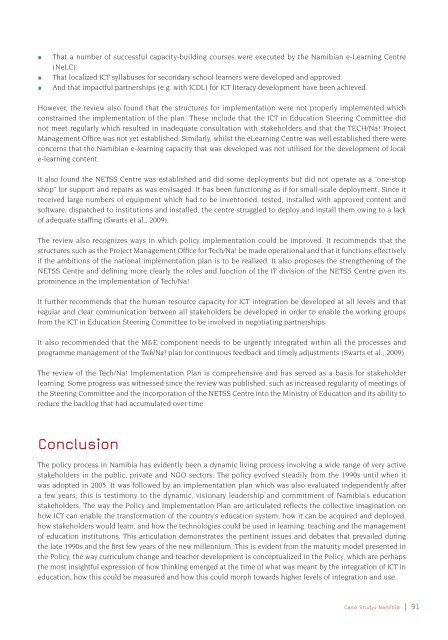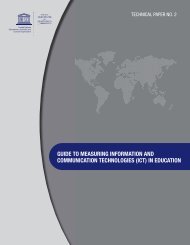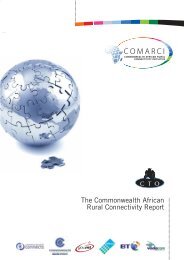Transforming education: the power of ICT policies - Commonwealth ...
Transforming education: the power of ICT policies - Commonwealth ...
Transforming education: the power of ICT policies - Commonwealth ...
You also want an ePaper? Increase the reach of your titles
YUMPU automatically turns print PDFs into web optimized ePapers that Google loves.
apple That a number <strong>of</strong> successful capacity-building courses were executed by <strong>the</strong> Namibian e-Learning Centre<br />
(NeLC).<br />
apple That localized <strong>ICT</strong> syllabuses for secondary school learners were developed and approved.<br />
apple And that impactful partnerships (e.g. with ICDL) for <strong>ICT</strong> literacy development have been achieved.<br />
However, <strong>the</strong> review also found that <strong>the</strong> structures for implementation were not properly implemented which<br />
constrained <strong>the</strong> implementation <strong>of</strong> <strong>the</strong> plan. These include that <strong>the</strong> <strong>ICT</strong> in Education Steering Committee did<br />
not meet regularly which resulted in inadequate consultation with stakeholders and that <strong>the</strong> TECH/Na! Project<br />
Management Offi ce was not yet established. Similarly, whilst <strong>the</strong> eLearning Centre was well established <strong>the</strong>re were<br />
concerns that <strong>the</strong> Namibian e-learning capacity that was developed was not utilised for <strong>the</strong> development <strong>of</strong> local<br />
e-learning content.<br />
It also found <strong>the</strong> NETSS Centre was established and did some deployments but did not operate as a “one-stop<br />
shop” for support and repairs as was envisaged. It has been functioning as if for small-scale deployment. Since it<br />
received large numbers <strong>of</strong> equipment which had to be inventoried, tested, installed with approved content and<br />
s<strong>of</strong>tware, dispatched to institutions and installed, <strong>the</strong> centre struggled to deploy and install <strong>the</strong>m owing to a lack<br />
<strong>of</strong> adequate staffi ng (Swarts et al., 2009).<br />
The review also recognizes ways in which policy implementation could be improved. It recommends that <strong>the</strong><br />
structures such as <strong>the</strong> Project Management Offi ce for Tech/Na! be made operational and that it functions effectively<br />
if <strong>the</strong> ambitions <strong>of</strong> <strong>the</strong> national implementation plan is to be realized. It also proposes <strong>the</strong> streng<strong>the</strong>ning <strong>of</strong> <strong>the</strong><br />
NETSS Centre and defi ning more clearly <strong>the</strong> roles and function <strong>of</strong> <strong>the</strong> IT division <strong>of</strong> <strong>the</strong> NETSS Centre given its<br />
prominence in <strong>the</strong> implementation <strong>of</strong> Tech/Na!<br />
It fur<strong>the</strong>r recommends that <strong>the</strong> human resource capacity for <strong>ICT</strong> integration be developed at all levels and that<br />
regular and clear communication between all stakeholders be developed in order to enable <strong>the</strong> working groups<br />
from <strong>the</strong> <strong>ICT</strong> in Education Steering Committee to be involved in negotiating partnerships<br />
It also recommended that <strong>the</strong> M&E component needs to be urgently integrated within all <strong>the</strong> processes and<br />
programme management <strong>of</strong> <strong>the</strong> Tech/Na! plan for continuous feedback and timely adjustments (Swarts et al., 2009).<br />
The review <strong>of</strong> <strong>the</strong> Tech/Na! Implementation Plan is comprehensive and has served as a basis for stakeholder<br />
learning. Some progress was witnessed since <strong>the</strong> review was published, such as increased regularity <strong>of</strong> meetings <strong>of</strong><br />
<strong>the</strong> Steering Committee and <strong>the</strong> incorporation <strong>of</strong> <strong>the</strong> NETSS Centre into <strong>the</strong> Ministry <strong>of</strong> Education and its ability to<br />
reduce <strong>the</strong> backlog that had accumulated over time.<br />
Conclusion<br />
The policy process in Namibia has evidently been a dynamic living process involving a wide range <strong>of</strong> very active<br />
stakeholders in <strong>the</strong> public, private and NGO sectors. The policy evolved steadily from <strong>the</strong> 1990s until when it<br />
was adopted in 2005. It was followed by an implementation plan which was also evaluated independently after<br />
a few years; this is testimony to <strong>the</strong> dynamic, visionary leadership and commitment <strong>of</strong> Namibia’s <strong>education</strong><br />
stakeholders. The way <strong>the</strong> Policy and Implementation Plan are articulated refl ects <strong>the</strong> collective imagination on<br />
how <strong>ICT</strong> can enable <strong>the</strong> transformation <strong>of</strong> <strong>the</strong> country’s <strong>education</strong> system, how it can be acquired and deployed,<br />
how stakeholders would learn, and how <strong>the</strong> technologies could be used in learning, teaching and <strong>the</strong> management<br />
<strong>of</strong> <strong>education</strong> institutions. This articulation demonstrates <strong>the</strong> pertinent issues and debates that prevailed during<br />
<strong>the</strong> late 1990s and <strong>the</strong> fi rst few years <strong>of</strong> <strong>the</strong> new millennium. This is evident from <strong>the</strong> maturity model presented in<br />
<strong>the</strong> Policy, <strong>the</strong> way curriculum change and teacher development is conceptualized in <strong>the</strong> Policy, which are perhaps<br />
<strong>the</strong> most insightful expression <strong>of</strong> how thinking emerged at <strong>the</strong> time <strong>of</strong> what was meant by <strong>the</strong> integration <strong>of</strong> <strong>ICT</strong> in<br />
<strong>education</strong>, how this could be measured and how this could morph towards higher levels <strong>of</strong> integration and use.<br />
Case Study: Namibia | 91
















